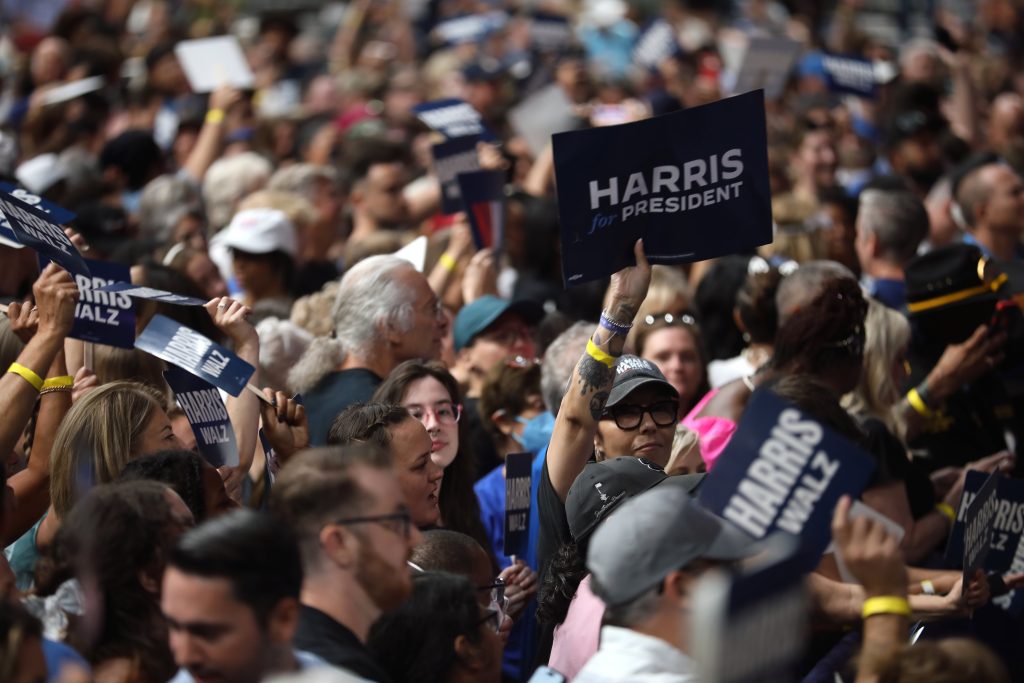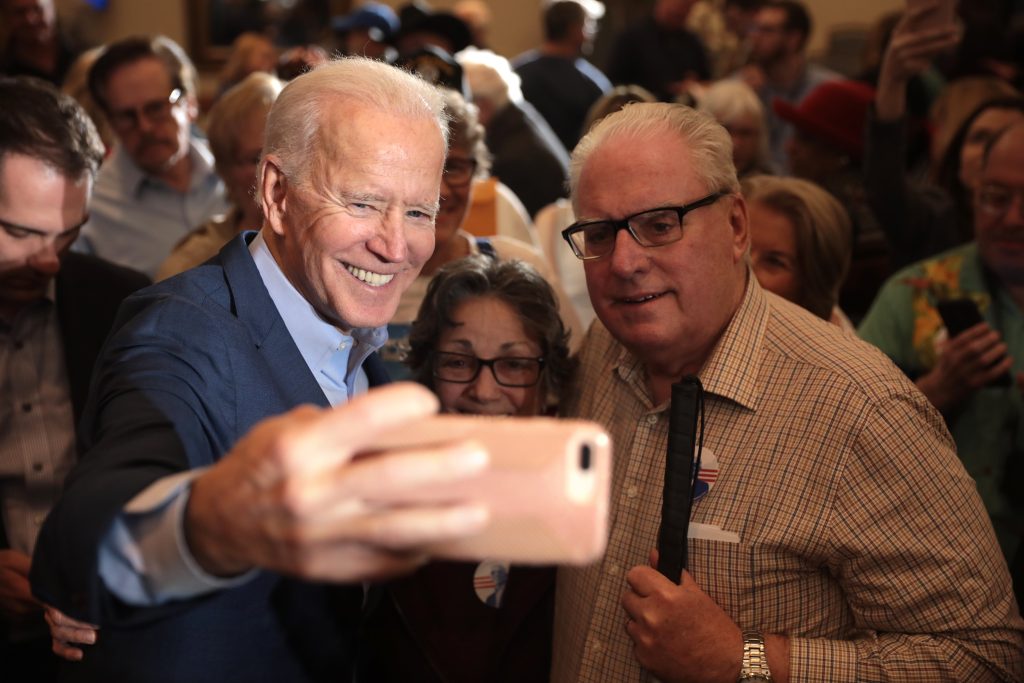By Dr Andy Bissell
Welcome to Bournemouth University’s coverage of the US Elections 2024. This is a project run by Bournemouth University students and staff covering the US Presidential Election.
We will be bringing you exclusive multimedia content throughout the night. This is your one-stop site for all the results, breaking news, analysis and comment. Keep checking our website and social media to keep up to date with all the latest US election news and results as the battle for the White House unfolds.
A simple introductory guide to the US Election
Who are the candidates and what do they stand for?
The two main parties, the Republicans and the Democrats, nominated their presidential candidates by holding a series of votes called state primaries and caucuses.
In the Republican Party, former President Trump won his party’s support with a huge lead over his rivals. Trump, who served as the 45th President of the US from 2017 to 2021, announced his campaign for the 2024 US presidential election on 15 November 2022.
He then won a landslide victory in the 2024 Iowa Republican presidential caucuses before being officially nominated on 5 July 2024 at the Republican National Convention in Milwaukee. Trump also announced JD Vance, a junior US Senator from Ohio, as the nominee for vice president.

The Republicans are traditionally the conservative political party in the US. Back in the 1870s, politicians and newspapers started to refer to the Republican Party as both the “grand old party” and the “gallant old party” to emphasize its role in maintaining the Union during the Civil War. Fast forward 150 years and the Grand Old Party continues to stand for lower taxes, shrinking the size of the government, gun rights and tighter restrictions on immigration and abortion.
For the Democrats, Vice-President Kamala Harris joined the race after President Joe Biden dropped out and no other Democrats stood against her. Her running mate is Minnesota Governor Tim Walz. The emergence of Harris as vice-president was a historic moment for the United States. Indeed, she become the first female, first black and first Asian American vice-president. Soon she could become the 47th president of the United States – the first woman in the role.

The Democrats are the liberal political party. Formed in 1828, it is the oldest continuing party in the US. with an agenda defined by its push for civil rights, a broad social safety net and measures to combat climate change.
Interestingly, the 2024 election will be the first since 1976 that does not include someone named Bush, Clinton or Biden on the ticket. Of course, Trump been here before – but Harris is a newbie.
Trump is aged 78 and is now the oldest major party presidential nominee in history after President Biden withdrew from contention. Harris turned 60 on 20 October.
The next president will be inaugurated on January 20, 2025.

Are there any other candidates?
Yes – three more but it’s very rare for any parties outside the big two to be competitive. The other candidates are: Jill Stein (Green Party), Cornel West (Independent) and Chase Oliver (Libertarian Party).
These candidates could have a significant impact on the election, though. Stein and West have strongly denounced Israel’s actions in Gaza and could siphon votes from the Democrats – particularly the votes of the young and progessive. Stein won more than 130,000 votes across Pennsylvania, Wisconsin and Michigan in 2016 – very significant when you consider Hillary Clinton lost by some 77,000 votes there.
How is the president elected?
Welcome to the complexities of America’s Electoral College system.
The first thing to stress is that the winner is not the candidate who gets the most votes across the US. Indeed, a candidate can win the largest share of the overall popular vote and lose. How?
This is because Trump and Harris will compete to win contests held across the 50 American states.
Each state is allocated a certain number of so-called ‘electoral college’ votes based partly on population. Hence, large populous states like California and Texas have 54 and 50 electoral college votes respectively while states like Delaware, Alaska. Vermont and Wyoming have just three each.
There is a total of 538 Electoral College votes up for grabs across the country, and the winner is the candidate who wins 270 or more.
The key point is this: It’s a ‘winner-takes-all’ rule – apart from in two states. This means whichever candidate wins the highest number of votes in a state ends up being awarded all of that state’s electoral college votes.
However, most states lean heavily towards one party or the other, so the focus is usually on those states where either of Trump or Harris could win.
Are those states the so-called ‘swing states’?
Yes. These are known as the ‘swing states’ or ‘battleground states. They will effectively decide the election. Seven swing states to look out for are Pennsylvania (19 Electoral College votes), North Carolina (16), Michigan (15), Wisconsin (10), Georgia (16), Nevada (6) and Arizona (11).
So, these key swing states collectively have 93 precious votes tied up with them – one third of the votes required to get to the magical winning post number of 270. Looked at another way, if the two candidates win all the states that will almost certainly vote for them, Harris will be 44 votes short of winning – and Trump 51. The 93 ‘either way’ swing state votes are therefore crucial.
So, to be clear, Harris or Trump could win the overall popular vote and still not become President?
Yes. Indeed, this is precisely what happened to Hillary Clinton in 2016. It also happened in 2000 and three times in the 1800s. In fact, polling suggests that Harris is likely to win the popular vote in 2024 but that won’t be enough. She still has to win key swing or battleground states to win in the Electoral College.
What’s the most important swing state?
Pennsylvania because it has the most Electoral College votes attached to it – 19. The state of the economy seems to be top of the list here among voters. In Pennsylvania, it may come down to whether voters felt better off four years ago under Trump – before record inflation hit personal income and budgets during Biden’s tenure.

What other things can sway swing state voters?
Take Michigan, for example. Biden won by just over 150,000 votes in 2020. This state has the highest concentration of Arab-American voters in America. The Democrats have been badly damaged by Biden’s perceived inability to prevent Israeli attacks in Gaza and Lebanon. So, Harris has a problem there.
It’s very close in Michigan which has 15 Electoral College votes up for grabs. Biden won this state in 2020 by about 150,000 votes – a narrow margin of 2.78%. In 2016, Trump won Michigan by an even narrower margin against Hillary Clinton – 0.23%. So watch out for Michigan’s vote, indeed all the swing states.
It is also important to remember that while Trump enjoys a big lead among men, Harris enjoys a big lead among female voters right across the US. Harris hasn’t played on the fact that there has never been a female president of the US. But her support of women’s reproductive rights could be a factor in swing states like Arizona where there is a proposition on the ballot to decide whether to enshrine abortion rights in the state constitution. This would effectively overturn the current law that bans terminating a pregnancy after 15 weeks.
The race for the presidency is currently too close to call, isn’t it?
Absolutely. When Harris became the Democratic presidential nominee two months ago, she certainly enjoyed a boost at the polls compared to President Biden who was lagging behind Trump. But it seems she may have been winning back those who would normally vote Democrat anyway. Harris needs to attract voters beyond the Democrats’ base. Meanwhile, Trump may have been gaining ground in places like Michigan, Pennsylvania and Wisconsin – all swing states. Trump may also be making inroads among Black and Latino voters.

Due to the importance of the swing states, the final result could in effect come down to the votes of a relatively few people?
Yes. Analysis published in the Sunday Times last week was very illuminating. There are about 336 million people living in the US and of those around 244 million are eligible to vote.
Moreover, there are probably around 30 million people living in the seven swing states of whom only 3-4 per cent – that’s approximately 1 million people – are persuadable, according to the US analyst, David Wasserman. This means that the outcome of the 2024 US election could ultimately be in the hands of less than 0.3 per cent of the population.
Both candidates will need to win at least three of the swing states to become president.
We noted earlier that if the two candidates win the states they expect to win, Harris will still be 44 votes short and Trump 51. Intriguingly, the three so-called ‘rust belt’ states – Michigan, Wisconsin and Pennsylvania – deliver 44 votes collectively. That’s exactly the number Harris needs to get over the line. If Trump wins these three states, he would still be seven votes short and would need another state’s votes.
So, will the rust belt states vote for Harris? The rust belt, the geographical area stretching from New York to Michigan, is the mid-west manufacturing and industrial heart of America that went into decline from the 1950s. It has a long history of voting Democrat and they have taken all three states in seven of the last eight elections. But all three turned to Trump in 2016.
With such fine margins, could the presidential election be a draw? What happens then?
If no candidate receives a majority of electoral votes, the vote goes to the House of Representatives. This has only happened twice. The first time was in the 1800 presidential election when the House chose Thomas Jefferson. Then, in 1824, the House selected John Quincy Adams as president.
Are there any other elections taking place?
Yes. American voters will also be choosing new members of Congress – where laws are passed – when they go to the polls.
Congress consists of the House of Representatives, currently controlled by Republicans, and the Democrat-controlled Senate.
All 435 seats are up for grabs in the House of Representatives, and 34 seats are being contested in the Senate.
While the House initiates spending plans, the Senate votes on key appointments in government. These two chambers pass laws and effectively act as a check on White House plans if the controlling party in either chamber disagrees with the president.
So when will we know who will be the next President of the US?
It’s difficult to say. That’s because the continental United States has four time zones. The polls start closing at 6pm Eastern Time in parts of Indiana and Kentucky, and ending at 11pm in California and Washington state. Then, an hour later, they close in Alaska and Hawaii.
The eyes of the world will be focussed on the results from the all-important swing states. When are these votes expected?
By 9pm, all of the crucial swing states will have finished voting – including Arizona and Nevada in the West. That’s 2am UK time on the morning of November 6.
That would normally mean that a result is clear by then.
But potential recounts in these closely fought states will slow down proceedings. Then there’s the ‘mail-in’ ballots which most states will not start counting until the polls are closed. That could further add to the delay.
Sources: usagov, BBC, CNN, The Sunday Times, London Standard, Sky News
Featured image courtesy of Gage Skidmore
